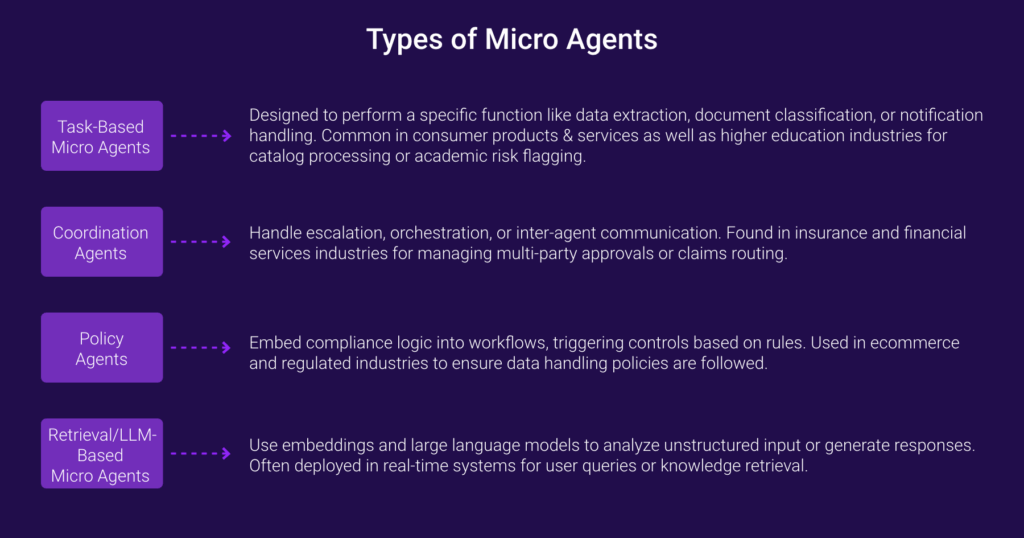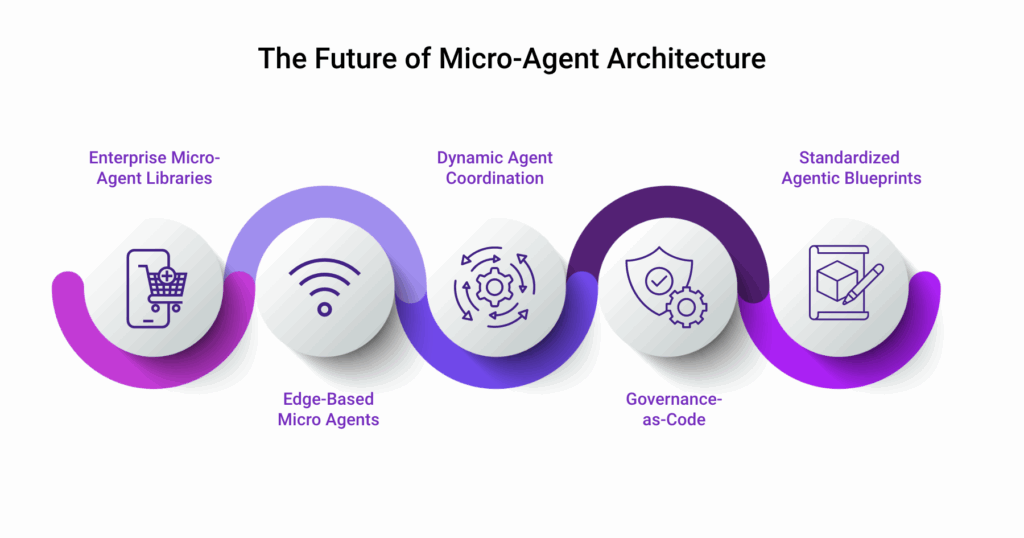A micro-agent architecture breaks complex workflows into goal-specific, autonomous units.
Micro-agent architecture refers to a modular AI system design where intelligent agents operate independently to perform specific tasks or decisions. These agents can interact, escalate, or collaborate across distributed systems, forming the backbone of scalable Agentic AI architecture.
Detailed Definition & Explanation
Micro-agent architecture is a design pattern in artificial intelligence where autonomous agents are structured to perform narrow, goal-oriented tasks independently, while still contributing to a larger coordinated system. It draws heavily from microservices architecture principles—favoring modularity, interoperability, and loose coupling—and applies them to AI agents that interact across domains and systems.
In these architectures, each micro agent operates within defined constraints but is capable of sensing inputs, reasoning over context, and taking actions on its own. These agents can be task-based (focused on completion of a discrete function) or coordination-based (focused on delegation, orchestration, or escalation). Micro-agent systems may run on-premises, in cloud-based AI systems, or on edge devices, making them especially suited for real-time, distributed environments.
From a technical standpoint, micro agents are often:
- Deployed as containers or functions within a service mesh
- Managed via agent registries or open source agent frameworks
- Configured to follow event-driven or goal-based execution paths
- Powered by lightweight models or embedded large language models (LLMs)
Micro-agent architectures are now being explored in open source agent frameworks like Semantic Kernel, where agents operate independently but adhere to common protocols. A typical micro-agent architecture example may involve an LLM-based agent performing context analysis, another handling tool invocation, and a third managing policy enforcement, all communicating asynchronously. This distributed model aligns with the future of AI, where agents act as microservices that improve agility, fault tolerance, and enterprise alignment.

Why It Matters
- Supports task-level intelligence without system-wide dependencies
Micro-agent architectures allow intelligent agents to execute specific tasks with autonomy, reducing system-wide coupling. In insurance, claims pre-processing agents can operate independently to validate forms and flag anomalies without relying on the central system’s availability. In financial services, micro-agents analyze compliance flags or transaction metadata on the fly, triggering alerts without interrupting broader operations.
- Enhances scalability and modular innovation across industries
Because each agent is modular, enterprises can plug in new capabilities or upgrade logic without impacting the entire system. In e-commerce, catalog ingestion agents process supplier sheets while other agents manage taxonomy corrections or SEO enhancements. In the consumer products & services industry, customer inquiry agents can be A/B tested for effectiveness without halting service.
- Improves system resilience through distributed execution
In a distributed system, micro agents operate across geographies or services, providing fault tolerance. In higher education, AI tutors and feedback agents operate across learning modules, ensuring that even if one fails, others continue functioning. In finance, micro-agents for risk scoring, identity checks, and policy triggers work in parallel to speed onboarding and reduce downtime.
- Enables governance and compliance at the edge of decision-making
Agents embedded with policy engines can take localized actions while still aligning with enterprise governance. In the consumer products & services industry, this allows pricing agents to adjust dynamically based on promotions while staying within approved thresholds. In insurance, policy insight agents block or redact outputs based on regulatory tags, all without human intervention.
- Lays the foundation for Agentic AI at enterprise scale
By decoupling decision-making into micro units, organizations can gradually scale into full Agentic AI systems. Each micro agent builds toward a broader mesh of collaborative, goal-driven intelligence. In e-commerce, fulfillment agents, fraud detectors, and campaign optimizers can be orchestrated into an adaptive, multi-agent strategy that improves in real time.
Real-World Examples
FD Ryze: Its multi-agent architecture enables organizations to deploy autonomous agents that perform real-time decisions and take actions across functions like underwriting, fraud detection, supplier validation, and claims triaging. The platform supports micro agents as microservices, ensuring they can operate independently while staying compliant with enterprise rules.
Microsoft Semantic Kernel: An open source agent framework that supports micro-agent design, allowing developers to plug LLM-based agents into existing workflows. It enables real-time agents to handle everything from scheduling to search retrieval using a modular skill-based system.
Amazon Bedrock + Agents for AWS: Amazon’s agent tooling allows developers to create based agents that perform discrete tasks like summarization or classification via LLMs, working independently or in sequence.
Zapier AI Agents: Though consumer-facing, Zapier’s recent agent model reflects micro-agent architecture principles, where each agent operates independently across apps to automate repetitive, specific tasks like invoice routing or Slack updates.

- Enterprise-wide micro-agent marketplaces will emerge
Organizations will begin maintaining internal marketplaces of reusable agents that are task-focused, secure, and pre-certified. These libraries will include role-based access, agent scoring, and deployment templates. To prepare, enterprises must catalog agent functionality, standardize metadata, and apply versioning controls for safe reusability.
- Micro agents will operate at the edge, closer to user actions
We’ll see increased deployment of micro agents on local devices or in low-latency environments, especially in retail, logistics, and education. These agents will operate offline or sync intermittently, requiring investments in compact inference models and edge-compliant policy layers.
- Agent coordination will become the new orchestration layer
Traditional orchestration tools will give way to agent-to-agent negotiation and delegation protocols. Micro agents will collaborate dynamically using shared goals, communication protocols, and event triggers. Enterprises must design interfaces that allow agents to pass context, resolve conflicts, and escalate responsibly.
- Governance will shift from top-down to embedded-by-design
Instead of monitoring outcomes after deployment, micro agents will carry embedded policies that trigger actions based on intent, sensitivity, or jurisdiction. To prepare, companies must adopt governance-as-code, runtime enforcement hooks, and decision traceability systems for distributed agents.
- Cross-industry reference architectures will standardize deployment
As adoption increases, industries will define standards and agent blueprints. From insurance to e-commerce, expect agentic AI architecture templates covering task types, communication models, and compliance requirements. Enterprise architects should track these frameworks and adapt their system design to remain interoperable and future-ready.
Related Terms
- Agentic AI Architecture
- Multi-Agent Systems
- Open Source Agent Framework
- Semantic Kernel
- Distributed Systems
- Large Language Models
